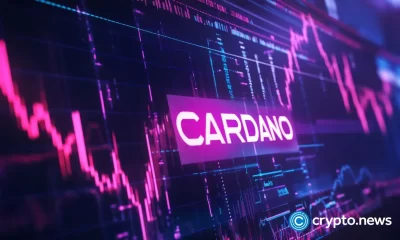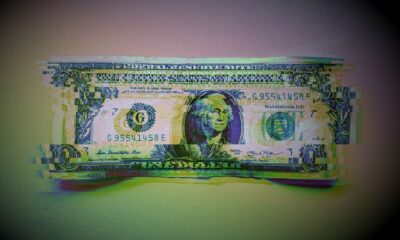Adoption
Museums, AI-generated art, blockchain, and NFTs
Published
3 months agoon
By
admin

Disclosure: The views and opinions expressed here belong solely to the author and do not represent the views and opinions of crypto.news’ editorial.
Refik Anadol Studio, co-founded by Refik Anadol and Efsun Erkiliç in 2025, is launching an immersive AI art & NFT museum called DATALAND at The Grand LA, with a flagship location at the Frank Gehry-designed development in the heart of downtown Los Angeles.
DATALAND will feature immersive AI art experiences by establishing a new model for artistic expression at the onset of the digital age by taking immersion to the next level with the AI-powered scent of the galleries. As AI artist Refik Anadol explained to me:
“We aren’t yet revealing the details about DATALAND’s artistic programming, but there will be many moments for sharing/exhibiting AI artists’ work both physically and virtually so people who cannot travel to LA have access to the AI art creations. And can purchase the AI art work NFTs minted on an Ethereum-based platform and many other sustainable chains for exciting art and culture activities.”
Refik Anadol Studio announced the launch of DATALAND during Climate Week NYC, which is celebrated NYS-wide for the first time and runs parallel to the United Nations General Assembly meeting, where world leaders gather to address critical global challenges. DATALAND’s inaugural exhibitions will be prepared with the Large Nature Model, an open-source AI model based solely on nature data, to produce unprecedented immersive AI-powered digital environmental artwork. The studio initially presented such installations at the 2024 World Economic Forum in Davos, Switzerland, and then at the United Nations in New York during the 2024 UNGA to promote environmental awareness. As UN Under-Secretary-General Melissa Fleming concurred:
“Refik Anadol’s artwork is a testament to the beauty and fragility of our natural world. It’s a clarion call to world leaders: we must harness the power of technology [AI art & NFTs] and human ingenuity and agency to incite action to protect our planet before it’s too late.”
The award-winning studio has been engaged by leading tech companies, groundbreaking researchers, and cutting-edge thought leaders to produce projects that have been shown in more than 70 cities spanning six continents and experienced by millions of ardent fans. These exhibition venues include several United Nations Climate Change Conferences, MoMA, Centre Pompidou-Metz, Serpentine Galleries, National Gallery of Victoria, Venice Architecture Biennale, Hammer Museum, Arken Museum, Casa Batlló, Dongdaemun Design Plaza, Daejeon Museum of Art, and Istanbul Modern Museum. Nevertheless, Refik Anadol Studio, as explained by Refik, chose “Los Angeles as the perfect city to launch DATALAND, a forward-thinking, revolutionary museum in support of the fields to which I have dedicated my career: art, science, technology, and AI research.” And he continued:
“As LA has long been a city that looks to the future in art, music, cinema, architecture, and more, it feels natural to open DATALAND here. To have a permanent space for us to develop a new paradigm of what a museum can be—by fusing human imagination with machine intelligence and the most advanced technologies available—is a realization of one of my biggest dreams. To do so in a building designed by one of my heroes, Frank Gehry, is almost unbelievable.”
DATALAND will use millions of photos and other records from partner museums, including the Smithsonian and London’s Natural History Museum, to create its installations. “We already have three major collaborations with museums in the works and are very confident to join forces across the world,” added Refik.
History of AI art, NFTs, and museums
Christiane Paul, the digital art curator of Whitney Museum, who is “looking forward to learning more about DATALAND,” detailed the AI Art History at the groundbreaking symposium at Rhode Island School of Design’s “Debates in AI” held during April 11-12, 2024, that invited artists worldwide. She explained that AI art has a fascinating history that intertwines technology and creativity, and it continues to evolve, pushing the boundaries of what is possible at the intersection of technology and creativity.
Christiane Paul, curator of Digital Art at Whitney Museum, debates in AI art history
Early beginnings: 1950s-1970s. The roots of AI art can be traced back to early experiments with computer-generated art, where artists and computer scientists collaborated to create visual and abstract compositions using early computer algorithms. One notable example from this era is captured by the Whitney Museum’s exhibition curated by Christiane Paul with David Lisbon tracing the evolution of Harold Cohen’s AARON, the earliest artificial intelligence program designed to create drawings and paintings. AARON was first exhibited in 1972 at the Los Angeles County Museum of Art.
Advancements in algorithms: 1980s-2000s. During this period, algorithms and computing power advancements allowed for more complex and varied artistic outputs, and AI art began to gain recognition in academic and artistic circles.
The city of Los Angeles, which will become home to DATALAND, served as grounds for the Gray Area Foundation, a cultural incubator with a mission to cultivate, sustain, and apply antidisciplinary collaboration, back in 2002 to integrate art, technology, science, AI, and the humanities—towards a more equitable and regenerative future. This foundation moved its headquarters to San Francisco in 2005.
Deep learning revolution: 2010s. The advent of deep learning brought significant changes with generative adversarial networks and other machine learning techniques that enabled the creation of highly sophisticated and realistic artworks. AI art started to be exhibited in NFT form in galleries and museums and auctioned in prominent auction houses, raising questions about creativity and authorship.
In 2014, digital artist Kevin McCoy issued the first-ever art NFT.
Four years later, in 2018, Christie’s art auction house became the first auction house ever to offer AI artwork for sale. Christie’s also hosted its first Art + Tech Summit on the topic of blockchain. In June 2019, the second edition focused on artificial intelligence and art. Since then, blockchain, NFTs, and AI have been hot topics in the art world, intersecting unexpectedly. At the helm of digital curator Christiane Paul, Whitney Museum became an early collector of NFTs starting in 2018.
Mainstream adoption: 2020s. The increased availability of AI art tools to the general public has democratized the creation of AI-generated images. This era has also seen debates about NFTs, its market bubble and crash, copyright, the impact on traditional artists, and the ethical implications of AI in art.
In Germany, the Intelligent Museum—a practice-based research and development project at the ZKM | Center for Art and Media Karlsruhe and the German Museum—was backed by the Digital Culture Programme of the German Federal Cultural Foundation in 2020. It explores new paths of museum communication and outreach to connect the museum with current AI technologies, making it a place of experience and experimentation, a social space where art, science, technology, and public discourse come together. One of the best-selling AI-generated NFT artists exhibited at ZKM is a program called Botto, which is the brainchild of computer engineers and a German artist named Mario Klingemann in 2021 that creates AI art NFTs. Today, Botto has created over 75 NFTs that generated more than $3 million in revenue.
In New York City, the Museum of Modern Art—ahead of holding its first-ever AI Art Show curated by Michelle Kuo, “Unsupervised” by Refik Anadol—became the beneficiary of a major new endowment established by the William S. Paley Foundation to support MoMA’s ambitious goals in digital media and technology and to provide for new AI Art/NFT acquisitions. Henry Kissinger, Chairman of the William S. Paley Foundation at the time, stated:
“I know how deeply my friend Bill Paley cared about The Museum of Modern Art and with what devotion he dedicated himself to its advancement. With this initiative, the Foundation will honor his intention and continue his vision for MoMA.”
Nevertheless, MoMA has adopted a cautious approach to NFTs so far. Other than contributing data to algorithmically generated works by artist Refik Anadol and, in October 2023, announcing that it had acquired “Unsupervised” for its permanent collection, the museum has not been involved with other AI art or NFT projects.
In Singapore, curated by ArtScience Museum’s Deborah Lim and guest curator Clara Che Wei Peh, “Notes From the Ether” last year was an exciting and timely exhibition that offered a glimpse into the future of digital art with work by 20 artists: Memo Akten, Burak Arikan, Botto, Mitchell F Chan, DEAFBEEF Simon Denny, Harm van den Dorpel, Sarah Friend, Rimbawan Gerilya, Holly Herndon and Mathew Dryhurst, Tyler Hobbs and Dandelion Wistjo+kapi, Larva Labs, Jonas Lund, Ninaad Kothawade, Sarah Meyohas, Rhea Myers, Aaron Penne, Aluan Wang, Emily Xie. These artists work with the emerging technologies of non-fungible tokens and generative artificial intelligence to push the boundaries of what art is and what it could be.
The future of museums AI art and NFTs
Undoubtedly, over the past 40 years, the usage of AI-generated art has been on the rise, becoming all the more popular during the last ten years with the tokenization of art via NFTs, according to the Academy of Animated Art. As Vilas Dhar, President of the Patrick J. McGovern Foundation, explained:
“AI is not just a tool for innovation—it’s a force that can reshape how we see our planet, reconnecting us with the beauty and fragility of nature in ways never before possible. Refik Anadol’s brilliant vision allows us to use technology [AI Art & NFTs] to engage the senses and spark a deeper emotional connection to our natural world.”
During this year, many museums and more than 100 “immersive” institutions around the world are showcasing/purchasing AI art and NFTs on a large scale to massive audiences to exhibit the marriage of human imagination and machine intelligence, which includes Seattle NFT Museum, Guggenheim Museum, Mercer Labs, Museum of Art & Light, Buffalo AKG Art Museum, Centre Pompidou, Tate Modern, PST Art: Art & Science Collide, which held at over 60 shows across Southern California, and many others.
Magda Shawon, co-founder of Postmasters Gallery in New York City, who works with the first NFT Artist Kevin McCoy, has been selling digital, AI-generated art to museums such as MoMA, the Metropolitan Museum of Art, and The Whitney Museum of American Art for over 20 years. She agrees with Vilas and Melissa’s sentiments about Refik’s impactful AI artwork:
“People don’t want to stop watching Refik Anadol’s AI Work when they sit in front of it. Refik’s work has an impact, but whether it is a trigger to create an enormous field of AI generative art, NFT sales is a big question.”
Digital art has been collected for as long as it has existed, but widespread adoption is still nascent. The tokenization of art via NFTs has helped the digital art world and the traditional art world integrate, leading to a burgeoning interest from museums, immersive institutions, collectors, auction houses, NFT markets, and galleries. The first NFT artist, Kevin McCoy, who created an art NFT back in 2014, is hopeful and supports Refik’s museum, AI art, and NFT initiative. He highlighted:
“I’m heartened by Anadol’s announcement of Dataland. He is leading by example both with his ‘ethical AI’ initiative and the commitment to the exhibition and preservation of AI and digital art that the museum represents. Within this context, the provenance provided by NFTs and blockchain-based records, more generally, can play a central role. This will be an important next step in the expanding use of this technology.”
Source link
You may like


XRP’s $5, $10 goals are trending, but this altcoin with 7,400% potential takes the spotlight


CryptoQuant Hails Binance Reserve Amid High Leverage Trading


Trump Picks Bo Hines to Lead Presidential Crypto Council


The introduction of Hydra could see Cardano surpass Ethereum with 100,000 TPS


Top 4 Altcoins to Hold Before 2025 Alt Season


DeFi Protocol Usual’s Surge Catapults Hashnote’s Tokenized Treasury Over BlackRock’s BUIDL
Adoption
Ohio introduces second Bitcoin reserve bill
Published
3 days agoon
December 19, 2024By
admin

The State of Ohio has introduced a second Bitcoin reserve bill as crypto legislation gains momentum across the U.S. ahead of Donald Trump’s inauguration.
Ohio House GOP Majority Whip Steve Demetriou proposed legislation to allow the state to manage a strategic Bitcoin (BTC) reserve, Satoshi Act Fund founder Dennis Porter shared on Dec. 19 during an X Spaces event.
Demetriou’s bill follows a similar proposal from Representative Derek Merrin, which would also position Ohio as a Bitcoin reserve holder. Speaking on X Spaces, Demetriou explained that his legislation would enable Ohio to allocate up to 10% of its state-controlled funds toward a BTC stockpile.
“Bitcoin can help tap into Ohio’s existing energy reserves,” Demetriou added. Ohio is famed for having massive natural gas reserves and a competitive energy grid.
The Ohio GOP Majority Whip provided no specific timeline for the bill’s passage but expressed hope that House bureaucracy would not delay progress.
BREAKING: Ohio introduces a 2nd bill to create a Strategic Bitcoin Reserve. This will be the lawmaker that passes it into law.
— Dennis Porter (@Dennis_Porter_) December 19, 2024
American legislative conversations have increasingly focused on BTC-related proposals following President-elect Donald Trump’s victory in the recent election.
Earlier, Porter said that the Bitcoin renaissance was spotted amassing momentum in over 12 states and counting. Texas, Ohio, and Pennsylvania were a few states that weighed BTC reserve laws.
In Washington, Senator Cynthia Lummis has advocated for federal BTC reserve policies. Responding to Federal Reserve Chair Jerome Powell, Lummis argued that the Senate should authorize the central bank to hold Bitcoin. Powell previously clarified that the Fed cannot own BTC under current laws.
Source link
Adoption
Wyoming seeks developers for state-backed stablecoin
Published
2 weeks agoon
December 9, 2024By
admin

The State of Wyoming is hiring blockchain developers to support the creation of its government-issued stablecoin currency.
The Wyoming Stable Token Commission has issued public Requests for Qualification to attract talent for its stablecoin initiative, known as “Project WYST.”
Stablecoins are digital currencies that trade with 1:1 dollar parity, allowing users to deploy U.S. dollars in blockchain markets and decentralized finance venues. The sector has over $200 billion in circulation, and stabelcoins feature in most cryptocurrency transactions, according to the U.S. Treasury Department.
Applicants have until Dec. 12 to submit their proposals for roles that include token development, support, listing, on-chain analysis, reserve management, financial auditing, and ecosystem intelligence.
WYST details remain limited, but Commission discussions indicate it may launch on Ethereum or Solana networks.
ICYMI: our public Request For Qualification period is underway.
7 RFQs are now open to support the development of the world’s first state-issued and fiat-backed stabletoken.
Submission deadline is Dec 12 2024 @ 5PM MT.
Apply now at the RFQ Info Center: https://t.co/u5OKK0QHWm
— wyostable (@wyostable) December 4, 2024
The Wyoming Stable Token Act, passed in 2023, authorized the state to issue stablecoins. According to the WyoStable Commission website, WYST is designed to represent and be redeemable for one U.S. dollar held in trust by the state. Tokens will only be issued in exchange for U.S. dollars.
WYST is a proposed virtual currency representative of and redeemable for one (1) United States dollar held in trust by the state of Wyoming as provided by W.S. 40‑31‑106. Stable tokens shall only be issued in exchange for United States dollars.
WyoStable Commission website
Wyoming has positioned itself as a web3 leader with U.S. borders. In March, the state officially recognized decentralized autonomous organizations as legal entities.
The landmark crypto bill reaffirmed sovereign acceptance for DAOs amid regulatory uncertainty, predominantly from the Securities and Exchange Commission. Kraken also launched its licensed custody solution in the state in March.
Back in February 2023, local lawmakers passed a bill to protect crypto self-custody, protecting the right to hold Bitcoin (BTC) and other digital assets. Wyoming Senator Cynthia Lummis was at the forefront of Federal Congressional efforts to establish a national Bitcoin reserve. Thousands penned letters supporting her BITCOIN BILL, per crypto.news reporting.
Other states were following suit and mulled Bitcoin reserve legislation as the U.S. voted its first pro-BTC president in Republican Donald Trump.
Source link
Adoption
Bitcoin advocate hints at ‘strategic reserve’ laws in 10 US states
Published
3 weeks agoon
December 3, 2024By
admin

Satoshi Act Fund founder Dennis Porter announced that several U.S. states are preparing to propose legislation for sovereign Bitcoin reserves.
In an attempt to front-run President Donald Trump’s Bitcoin (BTC) promise, Porter has lobbied local policymakers to introduce legislation for BTC stockpiles across 10 state jurisdictions. Porter disclosed the development via an X thread, highlighting efforts from his Satoshi Act Fund organization toward passing Bitcoin-focused laws.
I can now officially confirm and announce that 10 states will be introducing ‘Strategic Bitcoin Reserves’ legislation here in the great United STATES of America. We are going to win with Bitcoin. We will lead the world. No one will come close. The word will follow our lead.
Dennis Porter, Satoshi Act Fund founder and CEO
The public BTC supported also announced a joint discussion with Wyoming Senator Cynthia Lummis regarding her BITCOIN ACT, suggesting that Porter has engaged federal lawmakers to position the U.S. as a Bitcoin leader.
Lummis’s proposal would transfer 207,000 BTC seized by authorities to the Treasury Department. The Senator also pushed to convert U.S. gold certificates to finance BTC purchases and accumulate one million coins over five years.
“The race is on. Let the game theory begin,” Porter tweeted, referring to President Trump’s plan to establish a government BTC stockpile from America’s existing $19 billion horde.
I am convinced I will pass Strategic Bitcoin Reserve legislation at the state level before @realDonaldTrump. The only way he wins is if he does an executive order the very first week he is in office.
The race is on.
Let the game theory begin.
— Dennis Porter (@Dennis_Porter_) December 3, 2024
Nations, states, and governments are rushing to grab portions of BTC’s 21 million fixed supply following Trump’s victory at the presidential polls. Within the U.S., Pennsylvania already passed a bill legalizing BTC payments and crypto self-custody. The state also introduced a bill paving the way for its own BTC reserve in November.
On the international front, Brazil’s Senate considered pitching a national BTC reserve to President Luiz Inácio Lula da SilvaCongressman Eros Biondini submitted the idea to Brazil’s Chamber of Deputies as crypto.news reported.
Source link

XRP’s $5, $10 goals are trending, but this altcoin with 7,400% potential takes the spotlight

CryptoQuant Hails Binance Reserve Amid High Leverage Trading

Trump Picks Bo Hines to Lead Presidential Crypto Council

The introduction of Hydra could see Cardano surpass Ethereum with 100,000 TPS

Top 4 Altcoins to Hold Before 2025 Alt Season

DeFi Protocol Usual’s Surge Catapults Hashnote’s Tokenized Treasury Over BlackRock’s BUIDL

DOGE & SHIB holders embrace Lightchain AI for its growth and unique sports-crypto vision

Will Shiba Inu Price Hold Critical Support Amid Market Volatility?

Chainlink price double bottoms as whales accumulate

Ethereum Accumulation Address Holdings Surge By 60% In Five Months – Details

Ripple Transfers 90M Coins, What’s Happening?

Filecoin, Monero, and Lunex dominate smart investor portfolios

Bitwise CIO Matt Hougan Predicts Institutional Interest in Altcoins, Says 2025 the Year of Crypto Diversification

How Low Will Ethereum Price Go By The End of December?

Analyst says buying this altcoin at $0.15 could be as profitable as buying ETH at $0.66
182267361726451435

Why Did Trump Change His Mind on Bitcoin?

Top Crypto News Headlines of The Week

New U.S. president must bring clarity to crypto regulation, analyst says

Will XRP Price Defend $0.5 Support If SEC Decides to Appeal?

Bitcoin Open-Source Development Takes The Stage In Nashville

Ethereum, Solana touch key levels as Bitcoin spikes

Bitcoin 20% Surge In 3 Weeks Teases Record-Breaking Potential

Ethereum Crash A Buying Opportunity? This Whale Thinks So

Shiba Inu Price Slips 4% as 3500% Burn Rate Surge Fails to Halt Correction

Washington financial watchdog warns of scam involving fake crypto ‘professors’

‘Hamster Kombat’ Airdrop Delayed as Pre-Market Trading for Telegram Game Expands

Citigroup Executive Steps Down To Explore Crypto
Mostbet Güvenilir Mi – Casino Bonus 2024

NoOnes Bitcoin Philosophy: Everyone Eats
Trending

 3 months ago
3 months ago182267361726451435

 Donald Trump5 months ago
Donald Trump5 months agoWhy Did Trump Change His Mind on Bitcoin?

 24/7 Cryptocurrency News4 months ago
24/7 Cryptocurrency News4 months agoTop Crypto News Headlines of The Week

 News4 months ago
News4 months agoNew U.S. president must bring clarity to crypto regulation, analyst says

 Price analysis4 months ago
Price analysis4 months agoWill XRP Price Defend $0.5 Support If SEC Decides to Appeal?

 Opinion5 months ago
Opinion5 months agoBitcoin Open-Source Development Takes The Stage In Nashville

 Bitcoin5 months ago
Bitcoin5 months agoEthereum, Solana touch key levels as Bitcoin spikes

 Bitcoin5 months ago
Bitcoin5 months agoBitcoin 20% Surge In 3 Weeks Teases Record-Breaking Potential


